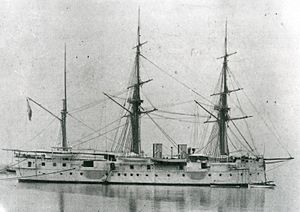Spanish cruiser Aragon facts for kids

Aragon
|
|
Quick facts for kids History |
|
|---|---|
| Name | Aragon |
| Namesake | The Kingdom of Aragon |
| Ordered | January 1869 |
| Builder | Naval shipyard at Cartagena, Spain |
| Laid down | 2 May 1869 |
| Launched | 31 July 1879 |
| Completed | 1880 |
| Decommissioned | mid-1890s |
| Fate | Hulked 1896. Either sold for scrap 1900 or stricken c. 1905 |
| General characteristics | |
| Class and type | Aragon-class unprotected cruiser |
| Displacement | 3,289 tons |
| Length | 236 ft 0 in (71.93 m) |
| Beam | 44 ft 0 in (13.41 m) |
| Draft | 23 ft 6 in (7.16 m) maximum |
| Installed power | 1,400 ihp (1,000 kW) |
| Propulsion | 1-shaft, 3-cylinder, horizontal compound |
| Sail plan | barque-rigged |
| Speed | 14 knots (26 km/h; 16 mph) |
| Range | 1,660 nmi (3,070 km; 1,910 mi) |
| Complement | 392 officers and enlisted |
| Armament |
|
| Notes | 460 tons of coal (normal) |
The Aragon was a type of warship called an unprotected cruiser that belonged to the Spanish Navy in the late 1800s. It was part of the Aragon class of ships.
Building the Aragon
The Aragon was built at the naval shipyard in Cartagena, Spain. Its construction began on May 2, 1869. The ship was first planned as an armored corvette, which is a smaller warship, with a central battery design. This meant it would have thick armor and its main guns would be in the middle of the ship.
However, political events in Spain caused delays in building the ship. In 1870, the plans for Aragon were changed. Instead of an armored ship, it became an unprotected cruiser. This means it did not have heavy armor to protect it.
The Aragon was finally launched on July 31, 1879, and finished in 1880. Because its design changed during construction, its wooden hull was very heavy. By the time it was finished, this design was already old-fashioned.
Ship Design and Weapons
The Aragon was designed to serve in Spain's colonies around the world. It had two funnels and was rigged like a barque, which means it had sails to help it move. The ship's engines were made by the John Penn Company in the United Kingdom.
When it was first completed, the Aragon's main guns were eight 8-inch (203 mm) guns made by Armstrong. These guns were not very modern for the time. So, in 1885, they were quickly replaced with newer 6.4-inch (163 mm) guns made by Hontoria. These new guns were heavier than those on its two sister ships, the Castilla and the Navarra. At least four of these guns were placed in special areas on the sides of the ship called sponsons. The ship also carried smaller guns, machine guns, and torpedo tubes.
Service History
In the 1890s, the Aragon was part of the Cadiz Naval Group, a collection of ships based in the city of Cadiz. It stopped being an active warship in the mid-1890s. By 1896, it became a floating hulk. This means it was no longer used for fighting but instead served as a stationary storage ship or a place for sailors to live.
There are different ideas about what happened to the Aragon after that. Some records say it was sold for scrap in 1900, meaning it was taken apart and its materials were reused. Other records suggest it was officially removed from the navy's list around 1905.
See also
In Spanish: Aragón (1879) para niños

